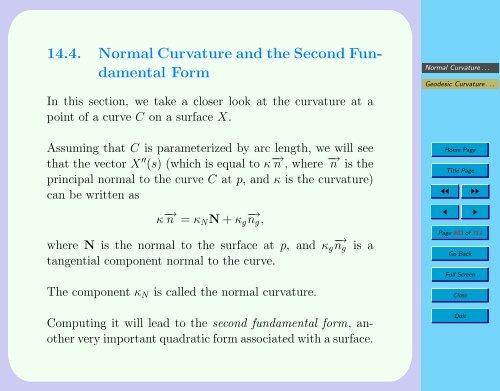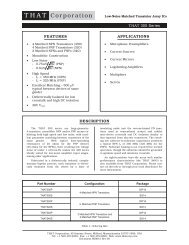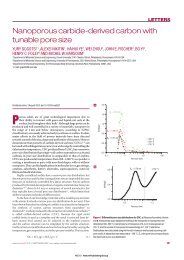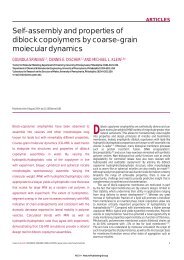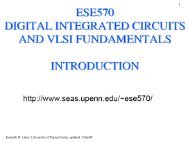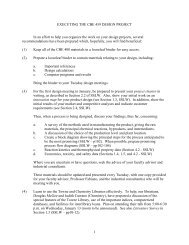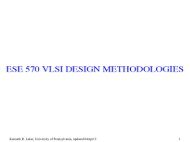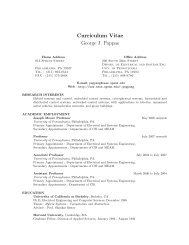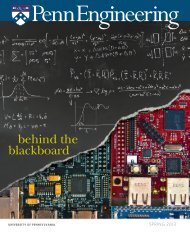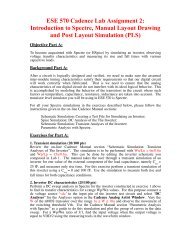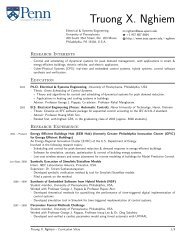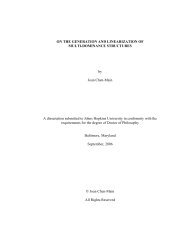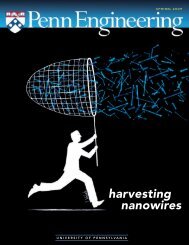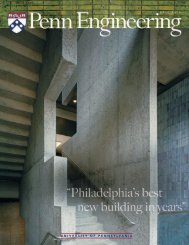14.4. Normal Curvature and the Second Fun- damental Form
14.4. Normal Curvature and the Second Fun- damental Form
14.4. Normal Curvature and the Second Fun- damental Form
Create successful ePaper yourself
Turn your PDF publications into a flip-book with our unique Google optimized e-Paper software.
<strong>14.4.</strong> <strong>Normal</strong> <strong>Curvature</strong> <strong>and</strong> <strong>the</strong> <strong>Second</strong> <strong>Fun</strong><strong>damental</strong><br />
<strong>Form</strong><br />
In this section, we take a closer look at <strong>the</strong> curvature at a<br />
point of a curve C on a surface X.<br />
<strong>Normal</strong> <strong>Curvature</strong> . . .<br />
Geodesic <strong>Curvature</strong> . . .<br />
Assuming that C is parameterized by arc length, we will see<br />
that <strong>the</strong> vector X ′′ (s) (which is equal to κ −→ n , where −→ n is <strong>the</strong><br />
principal normal to <strong>the</strong> curve C at p, <strong>and</strong> κ is <strong>the</strong> curvature)<br />
can be written as<br />
κ −→ n = κ N N + κ g<br />
−→ ng ,<br />
where N is <strong>the</strong> normal to <strong>the</strong> surface at p, <strong>and</strong> κ<br />
−→<br />
g ng<br />
tangential component normal to <strong>the</strong> curve.<br />
The component κ N is called <strong>the</strong> normal curvature.<br />
is a<br />
Home Page<br />
Title Page<br />
◭◭ ◮◮<br />
◭<br />
◮<br />
Page 683 of 711<br />
Go Back<br />
Full Screen<br />
Close<br />
Computing it will lead to <strong>the</strong> second fun<strong>damental</strong> form, ano<strong>the</strong>r<br />
very important quadratic form associated with a surface.<br />
Quit
The component κ g is called <strong>the</strong> geodesic curvature.<br />
It turns out that it only depends on <strong>the</strong> first fun<strong>damental</strong> form,<br />
but computing it is quite complicated, <strong>and</strong> this will lead to<br />
<strong>the</strong> Christoffel symbols.<br />
<strong>Normal</strong> <strong>Curvature</strong> . . .<br />
Geodesic <strong>Curvature</strong> . . .<br />
Let f: ]a, b[→ E 3 be a curve, where f is a least C 3 -continuous,<br />
<strong>and</strong> assume that <strong>the</strong> curve is parameterized by arc length.<br />
We saw in Chapter 13, section 13.6, that if f ′ (s) ≠ 0 <strong>and</strong><br />
f ′′ (s) ≠ 0 for all s ∈]a, b[ (i.e., f is biregular), we can associate<br />
to <strong>the</strong> point f(s) an orthonormal frame ( −→ t , −→ n , −→ b ) called <strong>the</strong><br />
Frenet frame, where<br />
Home Page<br />
Title Page<br />
◭◭ ◮◮<br />
◭<br />
◮<br />
Page 684 of 711<br />
Go Back<br />
−→ t = f ′ (s),<br />
−→ f ′′ (s) n =<br />
‖f ′′ (s)‖ ,<br />
−→ −→ b = t ×<br />
−→ n .<br />
Full Screen<br />
Close<br />
Quit
The vector −→ t is <strong>the</strong> unit tangent vector, <strong>the</strong> vector −→ n is<br />
called <strong>the</strong> principal normal, <strong>and</strong> <strong>the</strong> vector −→ b is called <strong>the</strong><br />
binormal.<br />
<strong>Normal</strong> <strong>Curvature</strong> . . .<br />
Geodesic <strong>Curvature</strong> . . .<br />
Fur<strong>the</strong>rmore <strong>the</strong> curvature κ at s is κ = ‖f ′′ (s)‖, <strong>and</strong> thus,<br />
f ′′ (s) = κ −→ n .<br />
Home Page<br />
Title Page<br />
The principal normal −→ n is contained in <strong>the</strong> osculating plane<br />
at s, which is just <strong>the</strong> plane spanned by f ′ (s) <strong>and</strong> f ′′ (s).<br />
◭◭<br />
◭<br />
◮◮<br />
◮<br />
Recall that since f is parameterized by arc length, <strong>the</strong> vector<br />
f ′ (s) is a unit vector, <strong>and</strong> thus<br />
f ′ (s) · f ′′ (s) = 0,<br />
which shows that f ′ (s) <strong>and</strong> f ′′ (s) are linearly independent <strong>and</strong><br />
orthogonal, provided that f ′ (s) ≠ 0 <strong>and</strong> f ′′ (s) ≠ 0.<br />
Page 685 of 711<br />
Go Back<br />
Full Screen<br />
Close<br />
Quit
Now, if C: t ↦→ X(u(t), v(t)) is a curve on a surface X, assuming<br />
that C is parameterized by arc length, which implies<br />
that<br />
(s ′ ) 2 = E(u ′ ) 2 + 2F u ′ v ′ + G(v ′ ) 2 = 1,<br />
we have<br />
X ′ (s) = X u u ′ + X v v ′ ,<br />
X ′′ (s) = κ −→ n ,<br />
<strong>and</strong> −→ t = X u u ′ + X v v ′ is indeed a unit tangent vector to <strong>the</strong><br />
curve <strong>and</strong> to <strong>the</strong> surface, but −→ n is <strong>the</strong> principal normal to <strong>the</strong><br />
curve, <strong>and</strong> thus it is not necessarily orthogonal to <strong>the</strong> tangent<br />
plane T p (X) at p = X(u(t), v(t)).<br />
Thus, if we intend to study how <strong>the</strong> curvature κ varies as<br />
<strong>the</strong> curve C passing through p changes, <strong>the</strong> Frenet frame<br />
( −→ t , −→ n , −→ b ) associated with <strong>the</strong> curve C is not really adequate,<br />
since both −→ n <strong>and</strong> −→ b will vary with C (<strong>and</strong> −→ n is undefined<br />
when κ = 0).<br />
<strong>Normal</strong> <strong>Curvature</strong> . . .<br />
Geodesic <strong>Curvature</strong> . . .<br />
Home Page<br />
Title Page<br />
◭◭ ◮◮<br />
◭<br />
◮<br />
Page 686 of 711<br />
Go Back<br />
Full Screen<br />
Close<br />
Quit
Thus, it is better to pick a frame associated with <strong>the</strong> normal<br />
to <strong>the</strong> surface at p, <strong>and</strong> we pick <strong>the</strong> frame ( −→ t , −→ n g , N) defined<br />
as follows.:<br />
Definition <strong>14.4.</strong>1 Given a surface X, given any curve<br />
C: t ↦→ X(u(t), v(t)) on X, for any point p on X, <strong>the</strong> orthonormal<br />
frame ( −→ t , −→ n g , N) is defined such that<br />
<strong>Normal</strong> <strong>Curvature</strong> . . .<br />
Geodesic <strong>Curvature</strong> . . .<br />
Home Page<br />
−→ t = Xu u ′ + X v v ′ ,<br />
N =<br />
X u × X v<br />
‖X u × X v ‖ ,<br />
−→ ng = N × −→ t ,<br />
where N is <strong>the</strong> normal vector to <strong>the</strong> surface X at p. The vector<br />
−→ ng is called <strong>the</strong> geodesic normal vector (for reasons that will<br />
become clear later).<br />
Title Page<br />
◭◭ ◮◮<br />
◭<br />
◮<br />
Page 687 of 711<br />
Go Back<br />
Full Screen<br />
Close<br />
For simplicity of notation, we will often drop arrows above<br />
vectors if no confusion may arise.<br />
Quit
Observe that −→ n g is <strong>the</strong> unit normal vector to <strong>the</strong> curve C<br />
contained in <strong>the</strong> tangent space T p (X) at p.<br />
<strong>Normal</strong> <strong>Curvature</strong> . . .<br />
Geodesic <strong>Curvature</strong> . . .<br />
If we use <strong>the</strong> frame ( −→ t , −→ n g , N), we will see shortly that<br />
X ′′ (s) = κ −→ n can be written as<br />
κ −→ n = κ N N + κ g<br />
−→ ng .<br />
The component κ N N is <strong>the</strong> orthogonal projection of κ −→ n onto<br />
<strong>the</strong> normal direction N, <strong>and</strong> for this reason κ N is called <strong>the</strong><br />
normal curvature of C at p.<br />
The component κ g<br />
−→ ng is <strong>the</strong> orthogonal projection of κ −→ n onto<br />
<strong>the</strong> tangent space T p (X) at p.<br />
Home Page<br />
Title Page<br />
◭◭ ◮◮<br />
◭<br />
◮<br />
Page 688 of 711<br />
Go Back<br />
Full Screen<br />
We now show how to compute <strong>the</strong> normal curvature. This will<br />
uncover <strong>the</strong> second fun<strong>damental</strong> form.<br />
Close<br />
Quit
Using <strong>the</strong> abbreviations<br />
X uu = ∂2 X<br />
∂u 2 ,<br />
X uv = ∂2 X<br />
∂u∂v ,<br />
X vv = ∂2 X<br />
∂v 2 ,<br />
<strong>Normal</strong> <strong>Curvature</strong> . . .<br />
Geodesic <strong>Curvature</strong> . . .<br />
since X ′ = X u u ′ + X v v ′ , using <strong>the</strong> chain rule, we get<br />
X ′′ = X uu (u ′ ) 2 + 2X uv u ′ v ′ + X vv (v ′ ) 2 + X u u ′′ + X v v ′′ .<br />
In order to decompose X ′′ = κ −→ n into its normal component<br />
(along N) <strong>and</strong> its tangential component, we use a neat trick<br />
suggested by Eugenio Calabi.<br />
Home Page<br />
Title Page<br />
◭◭ ◮◮<br />
◭<br />
◮<br />
Page 689 of 711<br />
Go Back<br />
Full Screen<br />
Close<br />
Quit
Recall that<br />
( −→ u × −→ v ) × −→ w = ( −→ u · −→ w ) −→ v − ( −→ w · −→ v ) −→ u .<br />
<strong>Normal</strong> <strong>Curvature</strong> . . .<br />
Geodesic <strong>Curvature</strong> . . .<br />
Using this identity, we have<br />
(N × (X uu (u ′ ) 2 + 2X uv u ′ v ′ + X vv (v ′ ) 2 ) × N<br />
= (N · N)(X uu (u ′ ) 2 + 2X uv u ′ v ′ + X vv (v ′ ) 2 )<br />
− (N · (X uu (u ′ ) 2 + 2X uv u ′ v ′ + X vv (v ′ ) 2 ))N.<br />
Since N is a unit vector, we have N·N = 1, <strong>and</strong> consequently,<br />
since<br />
κ −→ n = X ′′ = X uu (u ′ ) 2 + 2X uv u ′ v ′ + X vv (v ′ ) 2 + X u u ′′ + X v v ′′ ,<br />
we can write<br />
Home Page<br />
Title Page<br />
◭◭ ◮◮<br />
◭<br />
◮<br />
Page 690 of 711<br />
Go Back<br />
Full Screen<br />
κ −→ n = (N · (X uu (u ′ ) 2 + 2X uv u ′ v ′ + X vv (v ′ ) 2 ))N<br />
+ (N × (X uu (u ′ ) 2 + 2X uv u ′ v ′ + X vv (v ′ ) 2 )) × N<br />
+ X u u ′′ + X v v ′′ .<br />
Close<br />
Quit
Thus, it is clear that <strong>the</strong> normal component is<br />
κ N N = (N · (X uu (u ′ ) 2 + 2X uv u ′ v ′ + X vv (v ′ ) 2 ))N,<br />
<strong>Normal</strong> <strong>Curvature</strong> . . .<br />
Geodesic <strong>Curvature</strong> . . .<br />
<strong>and</strong> <strong>the</strong> normal curvature is given by<br />
κ N = N · (X uu (u ′ ) 2 + 2X uv u ′ v ′ + X vv (v ′ ) 2 ).<br />
Home Page<br />
Title Page<br />
Letting<br />
L = N · X uu , M = N · X uv , N = N · X vv ,<br />
◭◭ ◮◮<br />
◭<br />
◮<br />
Page 691 of 711<br />
we have<br />
κ N = L(u ′ ) 2 + 2Mu ′ v ′ + N(v ′ ) 2 .<br />
Go Back<br />
Full Screen<br />
Close<br />
Quit
It should be noted that some authors (such as do Carmo) use<br />
<strong>the</strong> notation<br />
e = N · X uu , f = N · X uv , g = N · X vv .<br />
Recalling that<br />
N =<br />
X u × X v<br />
‖X u × X v ‖ ,<br />
using <strong>the</strong> Lagrange identity<br />
we see that<br />
( −→ u · −→ v ) 2 + ‖ −→ u × −→ v ‖ 2 = ‖ −→ u ‖ 2 ‖ −→ v ‖ 2 ,<br />
‖X u × X v ‖ = √ EG − F 2 ,<br />
<strong>Normal</strong> <strong>Curvature</strong> . . .<br />
Geodesic <strong>Curvature</strong> . . .<br />
Home Page<br />
Title Page<br />
◭◭ ◮◮<br />
◭<br />
◮<br />
Page 692 of 711<br />
<strong>and</strong> L = N · X uu can be written as<br />
L = (X u × X v ) · X<br />
√ uu<br />
EG − F<br />
2<br />
= (X u, X v , X uu )<br />
√<br />
EG − F<br />
2 ,<br />
Go Back<br />
Full Screen<br />
Close<br />
Quit<br />
where (X u , X v , X uu ) is <strong>the</strong> determinant of <strong>the</strong> three vectors.
Some authors (including Gauss himself <strong>and</strong> Darboux) use <strong>the</strong><br />
notation<br />
D = (X u , X v , X uu ),<br />
D ′ = (X u , X v , X uv ),<br />
D ′′ = (X u , X v , X vv ),<br />
<strong>Normal</strong> <strong>Curvature</strong> . . .<br />
Geodesic <strong>Curvature</strong> . . .<br />
Home Page<br />
<strong>and</strong> we also have<br />
L =<br />
D<br />
√<br />
EG − F<br />
2 , M = D ′<br />
√<br />
EG − F<br />
2 , N = D ′′<br />
√<br />
EG − F<br />
2 .<br />
Title Page<br />
◭◭ ◮◮<br />
◭<br />
◮<br />
Page 693 of 711<br />
These expressions were used by Gauss to prove his famous<br />
Theorema Egregium.<br />
Since <strong>the</strong> quadratic form (x, y) ↦→ Lx 2 + 2Mxy + Ny 2 plays<br />
a very important role in <strong>the</strong> <strong>the</strong>ory of surfaces, we introduce<br />
<strong>the</strong> following definition.<br />
Go Back<br />
Full Screen<br />
Close<br />
Quit
Definition <strong>14.4.</strong>2 Given a surface X, for any point<br />
p = X(u, v) on X, letting<br />
L = N · X uu , M = N · X uv , N = N · X vv ,<br />
where N is <strong>the</strong> unit normal at p, <strong>the</strong> quadratic form (x, y) ↦→<br />
Lx 2 +2Mxy+Ny 2 is called <strong>the</strong> second fun<strong>damental</strong> form of X<br />
at p. It is often denoted as II p . For a curve C on <strong>the</strong> surface<br />
X (parameterized by arc length), <strong>the</strong> quantity κ N given by<br />
<strong>the</strong> formula<br />
κ N = L(u ′ ) 2 + 2Mu ′ v ′ + N(v ′ ) 2<br />
is called <strong>the</strong> normal curvature of C at p.<br />
The second fun<strong>damental</strong> form was introduced by Gauss in<br />
1827.<br />
<strong>Normal</strong> <strong>Curvature</strong> . . .<br />
Geodesic <strong>Curvature</strong> . . .<br />
Home Page<br />
Title Page<br />
◭◭ ◮◮<br />
◭<br />
◮<br />
Page 694 of 711<br />
Go Back<br />
Full Screen<br />
Close<br />
Unlike <strong>the</strong> first fun<strong>damental</strong> form, <strong>the</strong> second fun<strong>damental</strong><br />
form is not necessarily positive or definite.<br />
Quit
Properties of <strong>the</strong> surface expressible in terms of <strong>the</strong> first fun<strong>damental</strong><br />
are called intrinsic properties of <strong>the</strong> surface X.<br />
Properties of <strong>the</strong> surface expressible in terms of <strong>the</strong> second<br />
fun<strong>damental</strong> form are called extrinsic properties of <strong>the</strong> surface<br />
X. They have to do with <strong>the</strong> way <strong>the</strong> surface is immersed in<br />
E 3 .<br />
<strong>Normal</strong> <strong>Curvature</strong> . . .<br />
Geodesic <strong>Curvature</strong> . . .<br />
Home Page<br />
As we shall see later, certain notions that appear to be extrinsic<br />
turn out to be intrinsic, such as <strong>the</strong> geodesic curvature <strong>and</strong><br />
<strong>the</strong> Gaussian curvature.<br />
Title Page<br />
◭◭ ◮◮<br />
◭<br />
◮<br />
This is ano<strong>the</strong>r testimony to <strong>the</strong> genius of Gauss (<strong>and</strong> Bonnet,<br />
Christoffel, etc.).<br />
Page 695 of 711<br />
Go Back<br />
Full Screen<br />
Close<br />
Quit
Remark: As in <strong>the</strong> previous section, if X is not injective, <strong>the</strong><br />
second fun<strong>damental</strong> form II p is not well defined. Again, we<br />
will not worry too much about this, or assume X injective.<br />
<strong>Normal</strong> <strong>Curvature</strong> . . .<br />
Geodesic <strong>Curvature</strong> . . .<br />
It should also be mentioned that <strong>the</strong> fact that <strong>the</strong> normal<br />
curvature is expressed as<br />
κ N = L(u ′ ) 2 + 2Mu ′ v ′ + N(v ′ ) 2<br />
has <strong>the</strong> following immediate corollary known as Meusnier’s<br />
<strong>the</strong>orem (1776).<br />
Lemma <strong>14.4.</strong>3 All curves on a surface X <strong>and</strong> having <strong>the</strong><br />
same tangent line at a given point p ∈ X have <strong>the</strong> same normal<br />
curvature at p.<br />
In particular, if we consider <strong>the</strong> curves obtained by intersecting<br />
<strong>the</strong> surface with planes containing <strong>the</strong> normal at p, curves<br />
called normal sections, all curves tangent to a normal section<br />
at p have <strong>the</strong> same normal curvature as <strong>the</strong> normal section.<br />
Home Page<br />
Title Page<br />
◭◭ ◮◮<br />
◭<br />
◮<br />
Page 696 of 711<br />
Go Back<br />
Full Screen<br />
Close<br />
Quit
Fur<strong>the</strong>rmore, <strong>the</strong> principal normal of a normal section is collinear<br />
with <strong>the</strong> normal to <strong>the</strong> surface, <strong>and</strong> thus, |κ|=|κ N |, where κ<br />
is <strong>the</strong> curvature of <strong>the</strong> normal section, <strong>and</strong> κ N is <strong>the</strong> normal<br />
curvature of <strong>the</strong> normal section.<br />
<strong>Normal</strong> <strong>Curvature</strong> . . .<br />
Geodesic <strong>Curvature</strong> . . .<br />
We will see in a later section how <strong>the</strong> curvature of normal<br />
sections varies.<br />
Home Page<br />
We can easily give an expression for κ N for an arbitrary parameterization.<br />
Indeed, remember that<br />
( ) 2<br />
ds<br />
= ‖Ċ‖2 = E ˙u 2 + 2F ˙u ˙v + G ˙v 2 ,<br />
dt<br />
<strong>and</strong> by <strong>the</strong> chain rule<br />
u ′ = du<br />
ds = du dt<br />
dt ds ,<br />
Title Page<br />
◭◭ ◮◮<br />
◭<br />
◮<br />
Page 697 of 711<br />
Go Back<br />
Full Screen<br />
Close<br />
Quit
<strong>and</strong> since a change of parameter is a diffeomorphism, we get<br />
u ′ ˙u<br />
= ( )<br />
ds<br />
<strong>Normal</strong> <strong>Curvature</strong> . . .<br />
Geodesic <strong>Curvature</strong> . . .<br />
<strong>and</strong> from<br />
we get<br />
dt<br />
κ N = L(u ′ ) 2 + 2Mu ′ v ′ + N(v ′ ) 2 ,<br />
κ N = L ˙u2 + 2M ˙u ˙v + N ˙v 2<br />
E ˙u 2 + 2F ˙u ˙v + G ˙v 2 .<br />
Home Page<br />
Title Page<br />
◭◭ ◮◮<br />
◭<br />
◮<br />
Page 698 of 711<br />
It is remarkable that this expression of <strong>the</strong> normal curvature<br />
uses both <strong>the</strong> first <strong>and</strong> <strong>the</strong> second fun<strong>damental</strong> form!<br />
Go Back<br />
Full Screen<br />
We still need to compute <strong>the</strong> tangential part X ′′<br />
t of X ′′ .<br />
Close<br />
Quit
We found that <strong>the</strong> tangential part of X ′′ is<br />
<strong>Normal</strong> <strong>Curvature</strong> . . .<br />
X ′′<br />
t<br />
= (N × (X uu (u ′ ) 2 + 2X uv u ′ v ′ + X vv (v ′ ) 2 )) × N<br />
+ X u u ′′ + X v v ′′ .<br />
Geodesic <strong>Curvature</strong> . . .<br />
This vector is clearly in <strong>the</strong> tangent space T p (X) (since <strong>the</strong> first<br />
part is orthogonal to N, which is orthogonal to <strong>the</strong> tangent<br />
space).<br />
Fur<strong>the</strong>rmore, X ′′ is orthogonal to X ′ (since X ′ · X ′ = 1),<br />
<strong>and</strong> by dotting X ′′ = κ N N + X t ′′ with −→ t = X ′ , since <strong>the</strong><br />
component κ N N · −→ t is zero, we have X t ′′ · −→ t = 0, <strong>and</strong> thus<br />
X ′′<br />
t<br />
is also orthogonal to −→ t , which means that it is collinear<br />
with −→ n g = N × −→ t .<br />
Home Page<br />
Title Page<br />
◭◭ ◮◮<br />
◭<br />
◮<br />
Page 699 of 711<br />
Go Back<br />
Full Screen<br />
Close<br />
Quit
Therefore, we showed that<br />
κ −→ n = κ N N + κ g<br />
−→ ng ,<br />
<strong>Normal</strong> <strong>Curvature</strong> . . .<br />
Geodesic <strong>Curvature</strong> . . .<br />
where<br />
κ N = L(u ′ ) 2 + 2Mu ′ v ′ + N(v ′ ) 2<br />
<strong>and</strong><br />
Home Page<br />
κ g<br />
−→ ng = (N × (X uu (u ′ ) 2 + 2X uv u ′ v ′ + X vv (v ′ ) 2 )) × N<br />
+X u u ′′ + X v v ′′ .<br />
Title Page<br />
◭◭ ◮◮<br />
◭<br />
◮<br />
The term κ g<br />
−→ ng is worth an official definition.<br />
Page 700 of 711<br />
Go Back<br />
Full Screen<br />
Close<br />
Quit
Definition <strong>14.4.</strong>4 Given a surface X, given any curve<br />
C: t ↦→ X(u(t), v(t)) on X, for any point p on X, <strong>the</strong> quantity<br />
κ g appearing in <strong>the</strong> expression<br />
<strong>Normal</strong> <strong>Curvature</strong> . . .<br />
Geodesic <strong>Curvature</strong> . . .<br />
κ −→ n = κ N N + κ g<br />
−→ ng<br />
giving <strong>the</strong> acceleration vector of X at p is called <strong>the</strong> geodesic<br />
curvature of C at p.<br />
In <strong>the</strong> next section, we give an expression for κ g<br />
−→ ng in terms<br />
of <strong>the</strong> basis (X u , X v ).<br />
Home Page<br />
Title Page<br />
◭◭ ◮◮<br />
◭<br />
◮<br />
Page 701 of 711<br />
Go Back<br />
Full Screen<br />
Close<br />
Quit
14.5. Geodesic <strong>Curvature</strong> <strong>and</strong> <strong>the</strong> Christoffel<br />
Symbols<br />
We showed that <strong>the</strong> tangential part of <strong>the</strong> curvature of a curve<br />
C on a surface is of <strong>the</strong> form κ g<br />
−→ ng .<br />
<strong>Normal</strong> <strong>Curvature</strong> . . .<br />
Geodesic <strong>Curvature</strong> . . .<br />
We now show that κ n can be computed only in terms of <strong>the</strong><br />
first fun<strong>damental</strong> form of X, a result first proved by Ossian<br />
Bonnet circa 1848.<br />
The computation is a bit involved, <strong>and</strong> it will lead us to <strong>the</strong><br />
Christoffel symbols, introduced in 1869.<br />
Since −→ n g is in <strong>the</strong> tangent space T p (X), <strong>and</strong> since (X u , X v ) is<br />
a basis of T p (X), we can write<br />
form some A, B ∈ R.<br />
κ g<br />
−→ ng = AX u + BX v ,<br />
Home Page<br />
Title Page<br />
◭◭ ◮◮<br />
◭<br />
◮<br />
Page 702 of 711<br />
Go Back<br />
Full Screen<br />
Close<br />
Quit
However,<br />
<strong>Normal</strong> <strong>Curvature</strong> . . .<br />
κ −→ n = κ N N + κ g<br />
−→ ng ,<br />
Geodesic <strong>Curvature</strong> . . .<br />
<strong>and</strong> since N is normal to <strong>the</strong> tangent space,<br />
N · X u = N · X v = 0, <strong>and</strong> by dotting<br />
κ g<br />
−→ ng = AX u + BX v<br />
with X u <strong>and</strong> X v , since E = X u · X u , F = X u · X v , <strong>and</strong> G =<br />
X v · X v , we get <strong>the</strong> equations:<br />
Home Page<br />
Title Page<br />
◭◭ ◮◮<br />
◭<br />
◮<br />
κ −→ n · X u = EA + F B,<br />
κ −→ n · X v = F A + GB.<br />
Page 703 of 711<br />
Go Back<br />
Full Screen<br />
On <strong>the</strong> o<strong>the</strong>r h<strong>and</strong>,<br />
Close<br />
κ −→ n = X ′′ = X u u ′′ + X v v ′′ + X uu (u ′ ) 2 + 2X uv u ′ v ′ + X vv (v ′ ) 2 .<br />
Quit
Dotting with X u <strong>and</strong> X v , we get<br />
κ −→ n · X u = Eu ′′ + F v ′′ + (X uu · X u )(u ′ ) 2<br />
+ 2(X uv · X u )u ′ v ′ + (X vv · X u )(v ′ ) 2 ,<br />
κ −→ n · X v = F u ′′ + Gv ′′ + (X uu · X v )(u ′ ) 2<br />
+ 2(X uv · X v )u ′ v ′ + (X vv · X v )(v ′ ) 2 .<br />
<strong>Normal</strong> <strong>Curvature</strong> . . .<br />
Geodesic <strong>Curvature</strong> . . .<br />
Home Page<br />
Title Page<br />
At this point, it is useful to introduce <strong>the</strong> Christoffel symbols<br />
(of <strong>the</strong> first kind) [α β; γ], defined such that<br />
◭◭<br />
◭<br />
◮◮<br />
◮<br />
[α β; γ] = X αβ · X γ ,<br />
Page 704 of 711<br />
Go Back<br />
where α, β, γ ∈ {u, v}. It is also more convenient to let u = u 1<br />
<strong>and</strong> v = u 2 , <strong>and</strong> to denote [u α v β ; u γ ] as [α β; γ].<br />
Full Screen<br />
Close<br />
Quit
Doing so, <strong>and</strong> remembering that<br />
κ −→ n · X u = EA + F B,<br />
κ −→ n · X v = F A + GB,<br />
we have <strong>the</strong> following equation:<br />
( ) ( )<br />
E F A<br />
=<br />
F G B<br />
( ) ( )<br />
E F u<br />
′′<br />
1<br />
F G u ′′ + ∑ ( )<br />
[α β; 1] u<br />
′<br />
α u ′ β<br />
2 [α β; 2] u ′<br />
α=1,2<br />
αu ′ .<br />
β<br />
β=1,2<br />
<strong>Normal</strong> <strong>Curvature</strong> . . .<br />
Geodesic <strong>Curvature</strong> . . .<br />
Home Page<br />
Title Page<br />
◭◭ ◮◮<br />
◭<br />
◮<br />
However, since <strong>the</strong> first fun<strong>damental</strong> form is positive definite,<br />
EG − F 2 > 0, <strong>and</strong> we have<br />
(<br />
E F<br />
F G<br />
) −1 (<br />
= (EG − F 2 ) −1 G −F<br />
−F E<br />
)<br />
.<br />
Page 705 of 711<br />
Go Back<br />
Full Screen<br />
Close<br />
Quit
Thus, we get<br />
<strong>Normal</strong> <strong>Curvature</strong> . . .<br />
( ) A<br />
=<br />
B<br />
( ) u<br />
′′<br />
1<br />
u ′′<br />
2<br />
+ ∑ (<br />
(EG − F 2 ) −1 G<br />
−F<br />
α=1,2<br />
β=1,2<br />
−F<br />
E<br />
) ( [α β; 1] u<br />
′<br />
α u ′ β<br />
[α β; 2] u ′ αu ′ β<br />
)<br />
.<br />
Geodesic <strong>Curvature</strong> . . .<br />
Home Page<br />
Title Page<br />
It is natural to introduce <strong>the</strong> Christoffel symbols (of <strong>the</strong> second<br />
kind) Γ k i j , defined such that<br />
( ) Γ<br />
1<br />
i j<br />
Γ 2 i j<br />
(<br />
= (EG − F 2 ) −1 G −F<br />
−F E<br />
) ( ) [i j; 1]<br />
.<br />
[i j; 2]<br />
◭◭ ◮◮<br />
◭<br />
◮<br />
Page 706 of 711<br />
Go Back<br />
Full Screen<br />
Close<br />
Quit
Finally, we get<br />
<strong>and</strong><br />
A = u ′′<br />
1 + ∑ Γ 1 i j u ′ iu ′ j,<br />
i=1,2<br />
j=1,2<br />
B = u ′′<br />
2 + ∑ Γ 2 i j u ′ iu ′ j,<br />
i=1,2<br />
j=1,2<br />
<strong>Normal</strong> <strong>Curvature</strong> . . .<br />
Geodesic <strong>Curvature</strong> . . .<br />
Home Page<br />
Title Page<br />
κ g<br />
−→ ng = ⎛<br />
⎜ ⎝ u ′′<br />
1 + ∑ i=1,2<br />
j=1,2<br />
⎞<br />
Γ 1 i j u ′ iu ′ ⎟<br />
j⎠ X u +<br />
⎛<br />
⎜<br />
⎝u ′′<br />
2 + ∑ i=1,2<br />
j=1,2<br />
⎞<br />
Γ 2 i j u ′ iu ′ ⎟<br />
j⎠ X v .<br />
◭◭ ◮◮<br />
◭<br />
◮<br />
Page 707 of 711<br />
Go Back<br />
We summarize all <strong>the</strong> above in <strong>the</strong> following lemma.<br />
Full Screen<br />
Close<br />
Quit
Lemma 14.5.1 Given a surface X <strong>and</strong> a curve C on X, for<br />
any point p on C, <strong>the</strong> tangential part of <strong>the</strong> curvature at p is<br />
given by<br />
<strong>Normal</strong> <strong>Curvature</strong> . . .<br />
Geodesic <strong>Curvature</strong> . . .<br />
κ g<br />
−→ ng = ⎛<br />
⎜ ⎝ u ′′<br />
1 + ∑ i=1,2<br />
j=1,2<br />
⎞<br />
Γ 1 i j u ′ iu ′ ⎟<br />
j⎠ X u +<br />
⎛<br />
⎜<br />
⎝u ′′<br />
2 + ∑ i=1,2<br />
j=1,2<br />
⎞<br />
Γ 2 i j u ′ iu ′ ⎟<br />
j⎠ X v ,<br />
where <strong>the</strong> Christoffel symbols Γ k i j are defined such that<br />
( ) ( ) Γ<br />
1 −1 ( )<br />
i j E F [i j; 1]<br />
=<br />
,<br />
F G [i j; 2]<br />
Γ 2 i j<br />
<strong>and</strong> <strong>the</strong> Christoffel symbols [i j; k] are defined such that<br />
Note that<br />
[i j; k] = X ij · X k .<br />
[i j; k] = [j i; k] = X ij · X k .<br />
Home Page<br />
Title Page<br />
◭◭ ◮◮<br />
◭<br />
◮<br />
Page 708 of 711<br />
Go Back<br />
Full Screen<br />
Close<br />
Quit
Looking at <strong>the</strong> formulae<br />
[α β; γ] = X αβ · X γ<br />
for <strong>the</strong> Christoffel symbols [α β; γ], it does not seem that <strong>the</strong>se<br />
symbols only depend on <strong>the</strong> first fun<strong>damental</strong> form, but in fact<br />
<strong>the</strong>y do!<br />
After some calculations, we have <strong>the</strong> following formulae showing<br />
that <strong>the</strong> Christoffel symbols only depend on <strong>the</strong> first fun<strong>damental</strong><br />
form:<br />
[1 1; 1] = 1 2 E u, [1 1; 2] = F u − 1 2 E v,<br />
[1 2; 1] = 1 2 E v, [1 2; 2] = 1 2 G u,<br />
[2 1; 1] = 1 2 E v, [2 1; 2] = 1 2 G u,<br />
[2 2; 1] = F v − 1 2 G u, [2 2; 2] = 1 2 G v.<br />
<strong>Normal</strong> <strong>Curvature</strong> . . .<br />
Geodesic <strong>Curvature</strong> . . .<br />
Home Page<br />
Title Page<br />
◭◭ ◮◮<br />
◭<br />
◮<br />
Page 709 of 711<br />
Go Back<br />
Full Screen<br />
Close<br />
Quit
Ano<strong>the</strong>r way to compute <strong>the</strong> Christoffel symbols [α β; γ], is<br />
to proceed as follows. For this computation, it is more convenient<br />
to assume that u = u 1 <strong>and</strong> v = u 2 , <strong>and</strong> that <strong>the</strong> first<br />
fun<strong>damental</strong> form is expressed by <strong>the</strong> matrix<br />
( )<br />
g11 g 12<br />
=<br />
g 21 g 22<br />
where g αβ = X α · X β . Let<br />
Then, we have<br />
g αβ|γ = ∂g αβ<br />
∂u γ<br />
From this, we also have<br />
<strong>and</strong><br />
(<br />
E F<br />
F G<br />
g αβ|γ = ∂g αβ<br />
∂u γ<br />
.<br />
)<br />
,<br />
= X αγ · X β + X α · X βγ = [α γ; β] + [β γ; α].<br />
g βγ|α = [α β; γ] + [α γ; β],<br />
g αγ|β = [α β; γ] + [β γ; α].<br />
<strong>Normal</strong> <strong>Curvature</strong> . . .<br />
Geodesic <strong>Curvature</strong> . . .<br />
Home Page<br />
Title Page<br />
◭◭ ◮◮<br />
◭<br />
◮<br />
Page 710 of 711<br />
Go Back<br />
Full Screen<br />
Close<br />
Quit
From all this, we get<br />
2[α β; γ] = g αγ|β + g βγ|α − g αβ|γ .<br />
<strong>Normal</strong> <strong>Curvature</strong> . . .<br />
Geodesic <strong>Curvature</strong> . . .<br />
As before, <strong>the</strong> Christoffel symbols [α β; γ] <strong>and</strong> Γ γ α β<br />
via <strong>the</strong> Riemannian metric by <strong>the</strong> equations<br />
are related<br />
Home Page<br />
( ) −1<br />
Γ γ α β = g11 g 12<br />
[α β; γ].<br />
g 21 g 22<br />
◭◭<br />
Title Page<br />
◮◮<br />
This seemingly bizarre approach has <strong>the</strong> advantage to generalize<br />
to Riemannian manifolds. In <strong>the</strong> next section, we study<br />
<strong>the</strong> variation of <strong>the</strong> normal curvature.<br />
◭<br />
◮<br />
Page 711 of 711<br />
Go Back<br />
Full Screen<br />
Close<br />
Quit


